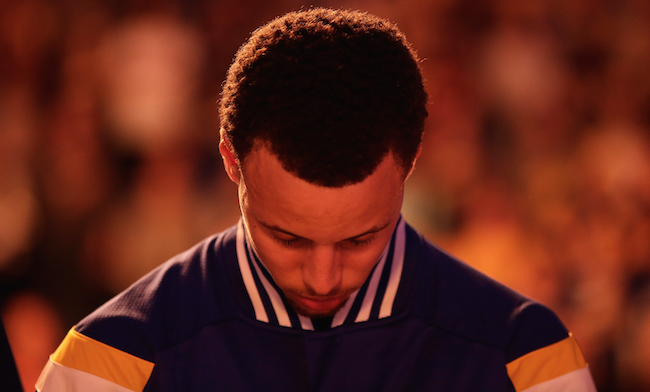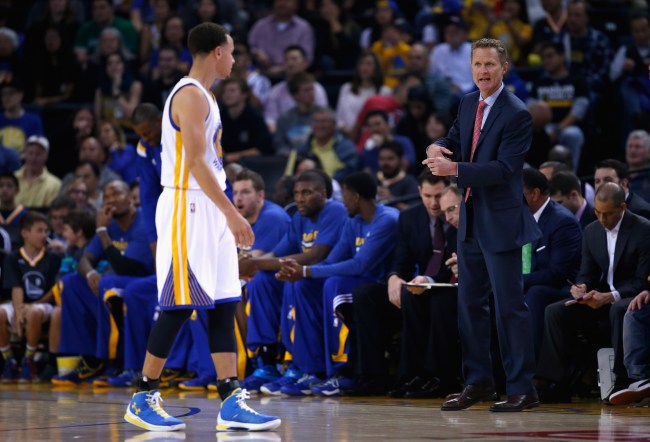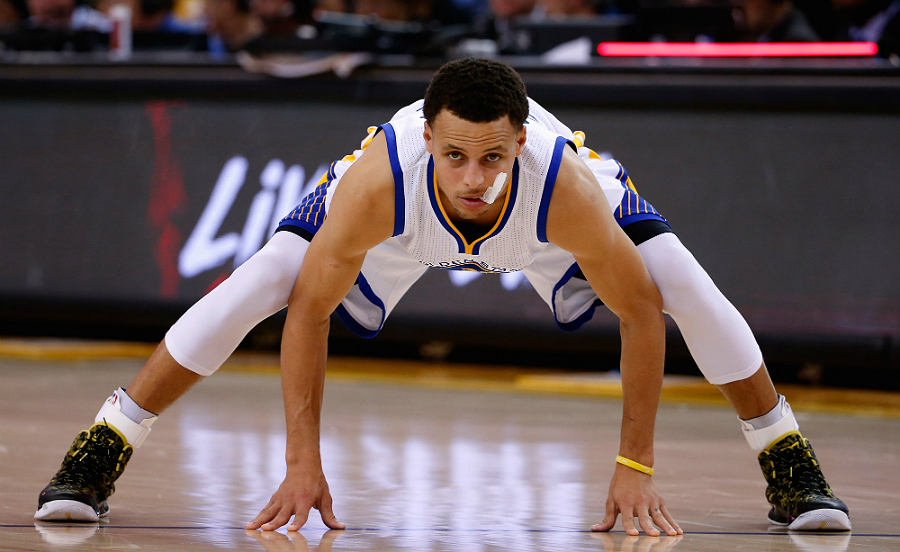
Steph Curry won’t win MVP for his defense. But if the Golden State Warriors make good on their dominant regular season and hoist the Larry O’Brien Trophy come early June, it just might be because of their best player’s dramatic improvement on that end of the floor.
You know all about Curry by now. He’s been a national name since bursting on the scene with little-known Davidson College during the 2008 NCAA Tournament, and rose to prominence in the professional ranks by leading the upstart ‘Dubs to a first round playoff upset of the Denver Nuggets two years ago.
The mind-bending shots, eye-opening dimes, and mesmerizing handles just aren’t surprising anymore, even as the 27-year-old has taken every aspect of his offensive game to new heights in 2014-2015. Curry’s majesty with and without the leather needs no further assessment – if he isn’t the game’s most influential player on that side of the ball, he’s among its top two or three at the very least.
[protected-iframe id=”07127f7dd74db2a7ac0125b25e414fe5-60970621-3039052″ info=”https://vine.co/v/OLx5PPAuQ0g/embed/simple” width=”750″ height=”750″ frameborder=”0″]
Which is perhaps the biggest reason why he’ll always be underappreciated defensively.
Guys who play like Curry – let alone look like him – just aren’t supposed to defend at an elite level, and most of them simply don’t want to on a possession-by-possession, game-by-game basis. There’s a reason LeBron James is chastised for “coasting” during the regular season and Chris Paul has made a habit of taking mid-season siestas, and it’s because the two-way onus their offensive and defensive abilities merit easily wears them down.
Dominant players just don’t need to defend full-bore during an 82-game regular season, and smart coaches won’t ask them to do so. But Curry has been out to prove a point defensively since the season tipped off in late October. And instead of pulling back the reigns on their determined prize horse, Steve Kerr and the Golden State staff are riding him harder than ever in their first year on the sidelines.
It’s a plan the Warriors’ new decision-makers put in place during the offseason.
Curry has been out to prove a point defensively since the season tipped off in late October.
The Plan

“I had it in my mind when I took the job that I felt it was important for him to guard more point guards,” Kerr told Tim Kawakami of the San Jose Mercury News in early February. “And when I spoke with him when I took the job, he actually brought it up before I did. So he wanted to do it.
“And then when I hired Ron Adams, that was about the first thing Ron said to me was, ‘Steph’s a lot better defensively than people know. He’s probably better than he knows. And we need to empower him and put him on more point guards and make him a more integral part of the defense.”
But the challenge would only work if the 190-pound, bible-thumping “Baby-Faced Assassin” took it on with aplomb outsiders simply assume he lacks. Adams, a highly respected and long-tenured NBA assistant lauded for his defensive acumen, never doubted Curry had the necessary mindset to supplement his underrated physical gifts and ballyhooed basketball intelligence to become a great defender.
“Steph is a polite, gracious and very kind human being,” Adams said last November, as reported by Diamond Leung of the Mercury News. “I know his parents. They did a fantastic job of raising both him and his brother. But underneath it all, he’s a killer at heart. And that’s how one should be.”
“Underneath it all, he’s a killer at heart. And that’s how one should be.”
Kerr, Adams, and company saw potential in Curry and decided to test it. For Golden State to reach its perceived defensive peak, they surmised a need for the head of the snake to bite. The departed Mark Jackson, by contrast, relegated his franchise player to checking the opposition’s least threatening perimeter option.
A familiar sight of Golden State games passed is Klay Thompson and Andre Iguodala guarding players like Paul and Russell Westbrook while Curry shifts down to manage Matt Barnes or Thabo Sefolosha. No longer. And it’s a development that Curry not only says he wished would have taken place long ago, but one for which he lobbied, too.
“[Jackson would] go to Klay and say, ‘You got C.P.,’ and he’d look at me,” Curry recalled early this season. “And I’m sitting here, shaking my head.
“So he knew… I talked to him a couple of times to just kind of get a reason for it. Obviously, it’s his decision, and I still have to do my job on the other guy. I wasn’t running from that at all. You have a little pride when it comes to that for sure.”
Pride that’s been evident in his defensive performance this season.
Golden State has the league’s best defense – by measures subjective and objective. No other roster in basketball boasts names like those of Andrew Bogut, Draymond Green, Iguodala, Shaun Livingston, and Thompson, each of whom would be considered their club’s best defensive player if employed somewhere other than Oakland. All of that talent has meshed perfectly with subtle adjustments made by Kerr and Adams to take the Warriors from a great defensive team to a peerless one in 2014-2015.
They rank first in defensive rating and opponent field goal percentage, doing so by putting an obvious emphasis on protecting the court’s prime real estate: the rim and three-point arc. Opponents rarely get to the restricted area against the Warriors and shoot only 57.8 percent when they do, the sixth-best number in the NBA. Likewise, no team prevents corner three-point attempts better than Golden State, and the opposition makes just 33.7 percent of its total tries from range – a mark among the league’s five worst.
Kerr has perfectly blended his unmatched personnel with a scheme that forces offenses into tough shots and discourages the ball from being swung side-to-side, using his litany of long-limbed, fleet-footed defenders to aggressively switch on- and off- ball screens whenever possible.
But that bold strategy is only as good as its weakest link. And fortunately for Kerr, there’s no obvious choice among his top seven players for that distinction — which might be as great a testament to Curry’s defensive growth as anything else.
Individual statistics and the eye-test, however, do a pretty good job of exhibiting it, too.

The Proof
Curry won’t ever look like Russell Westbrook, John Wall, or even Kyle Lowry on the floor. He’s slight of frame, has average length, and doesn’t posses the effortless gait of elite athletes. But the sixth year veteran has worked tirelessly to become wiry strong and sneaky quick, maturation that directly contributes to his increased effectiveness while defending.
Effort and IQ still loom largest for Curry, though. He’s engaged from the onset of defensive possessions, doesn’t give up on plays if briefly marginalized, and helps and recovers with the effectiveness of a faster, longer player.
Make no mistake – Steph’s hands are quick and strong. But he leads the NBA in swipes per game and boasts a career-best 3.1 steal percentage not because he rips ballhandlers with the ease of Kawhi Leonard, but because he’s constantly ready to take advantage of lapses by the offense.
It’s amazing how easily Steph tips pick-and-roll passes for steals simply by staying active when a normal defender would relax. This isn’t a guy with arms like Rajon Rondo, but a player who wants to win more than anything else and understands a reliable means to doing so is maximum engagement.
The same can be said for his steal work off the ball. Curry always sees his man and the ballhandler, routinely sneaking glances in the direction of the rock to come from the weak-side or jump a passing lane and get going the other way.
But energy only matters so much – many players could hunt steals or tips by abandoning the scheme to ball-hunt like Corey Brewer. It’s a select few who combine that defensive motor with smarts and accountability, and Curry is among them.
It’s a rare trait that Adams believes was born in his team’s superstar.
“He has a really good understanding about what’s going on on the floor,” the Warriors assistant told NBA.com’s Scott Howard-Cooper in February. “If you go back to a guy like John Stockton, John Stockton defensively, to me, he hustled and he worked hard and all that. But he was like the guy who had a handful of sand and he threw it in the gas tank. He knew exactly where to throw the sand to gum up an offense. Steph has that ability too. That’s another area I think he can exploit.”
Curry does just that – more than once! – on this single possession against the Atlanta Hawks.
See how he jumps on the high side of Paul Millsap’s pick once Jeff Teague catches? “ICEing” side ball-screens is a tactic Curry has mastered this season, and one that’s instrumental to Golden State’s defensive preeminence. Doing so keeps Teague on one side of the floor and forces him to swing the ball back to Kyle Korver. But Millsap quickly flips his pick the other direction upon the pass, stymying Curry as Teague flares off it to the wing.
But Green, the league’s ultimate defensive chameleon, is checking Millsap and immediately switches onto Teague to help his teammate. That leaves Curry mismatched on Atlanta’s best scorer, a player five inches taller and 50 pounds heavier than he is, and Steph starts on the wrong side of Millsap when Green initiates the switch. He quickly swims over the top of Millsap as the Hawks’ power forward dives to the block, though, getting low to front him. Millsap is forced to the corner to catch as a result, and that’s when Curry uses his quickness advantage to get a deflection that eventually leads to a Warriors steal.
A more subtle example of Curry “throwing sand in the gas tank” came in Golden State’s win over the Los Angeles Clippers on Tuesday.
Steph immediately jumps between the two-sided ball-screen from Blake Griffin and DeAndre Jordan, ensuring that Chris Paul has no easy choice on which direction to head. He nudges Jordan hard as Paul hesitates right and Andrew Bogut begins to drop behind him, and finally fights through the screen once the Clippers’ point guard takes another step towards the sideline – a decision he made because Jordan isn’t a perimeter threat and Paul is one of the best pull-up shooters in the game.
The reigning Point God’s body is still well in front of Curry’s once the latter commits, but effort rules the day again. Curry catches up to Paul with active hands by the time Bogut is engaged, leaving the ballhandler with no other option but to throw a nifty bounce pass back to the key.
A well contested 20-footer from Blake Griffin? Kerr will take that every time against any offense, let alone one like Los Angeles’, and Curry’s intelligence and persistence is what helped force that poor shot more than anything else.
Most every metric available supports the notion that Curry is a very good defender. He holds the players he’s guarding nearly three percent below their average shooting marks. The Warriors’ defensive rating jumps 3.1 points when he sits on the bench. Synergy rates him in the 87th percentile for overall defense, and lists him as no worse than “average” in each of the eight play-types the service categorizes.
But the narrative of his game won’t ever change. Even when Curry is at his nuanced yet disruptive best while guarding the ball, that influence will always be overshadowed by what he does with it in his hands.
Of his defensive ability, Curry recently said “whether people notice or not is not under my control.”
That’s true.
But what’s just as obvious is his rise to impactful defender has helped Golden State become a clear title favorite as the playoffs loom. And if it’s indeed the Warriors who emerge as the last team standing in June after navigating a gauntlet of superstar point guards, the majority may still not laud Curry’s defense, but they definitely won’t question it, either.
It’s a feat that would be no less impressive than bringing a championship back to the Bay for the first time in 40 years.






